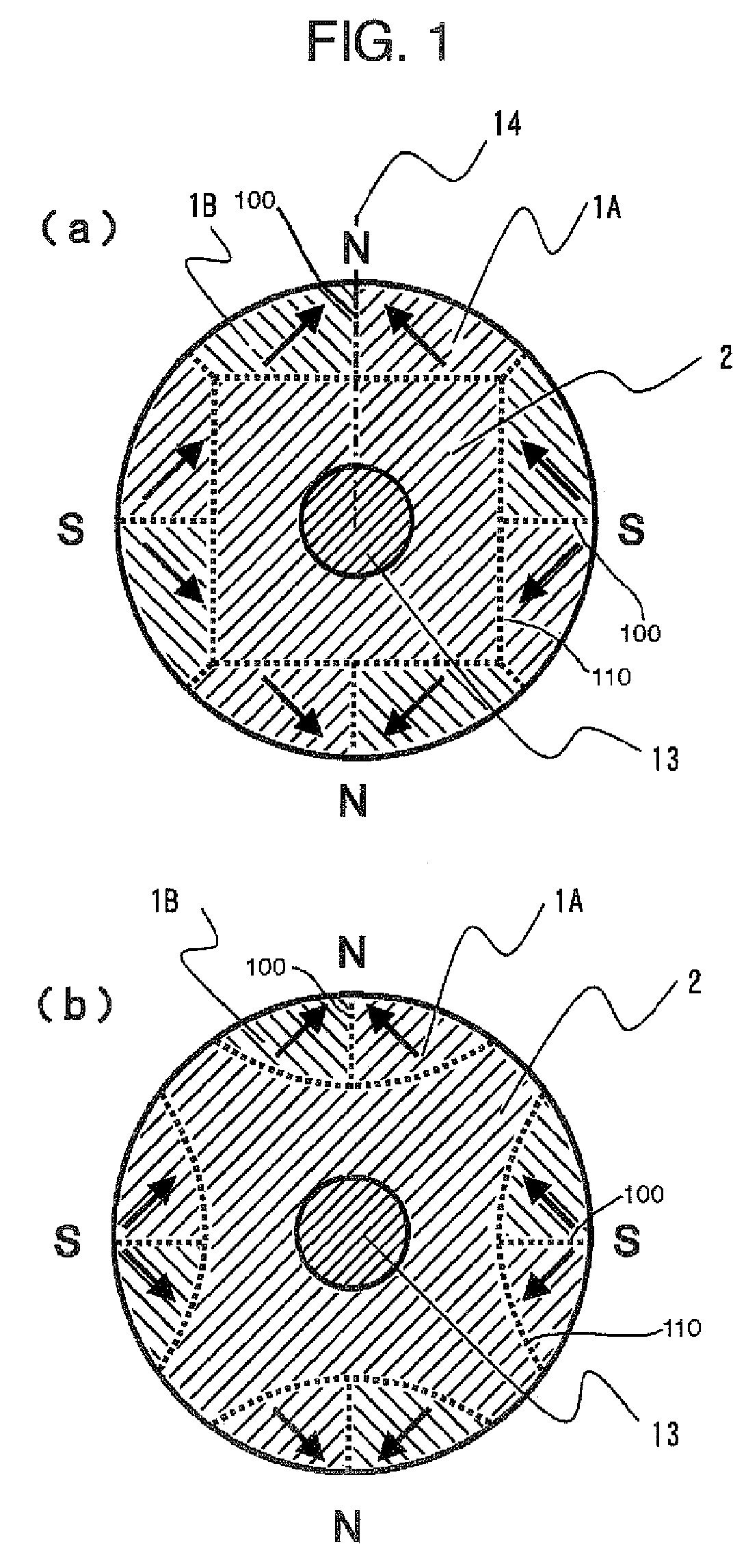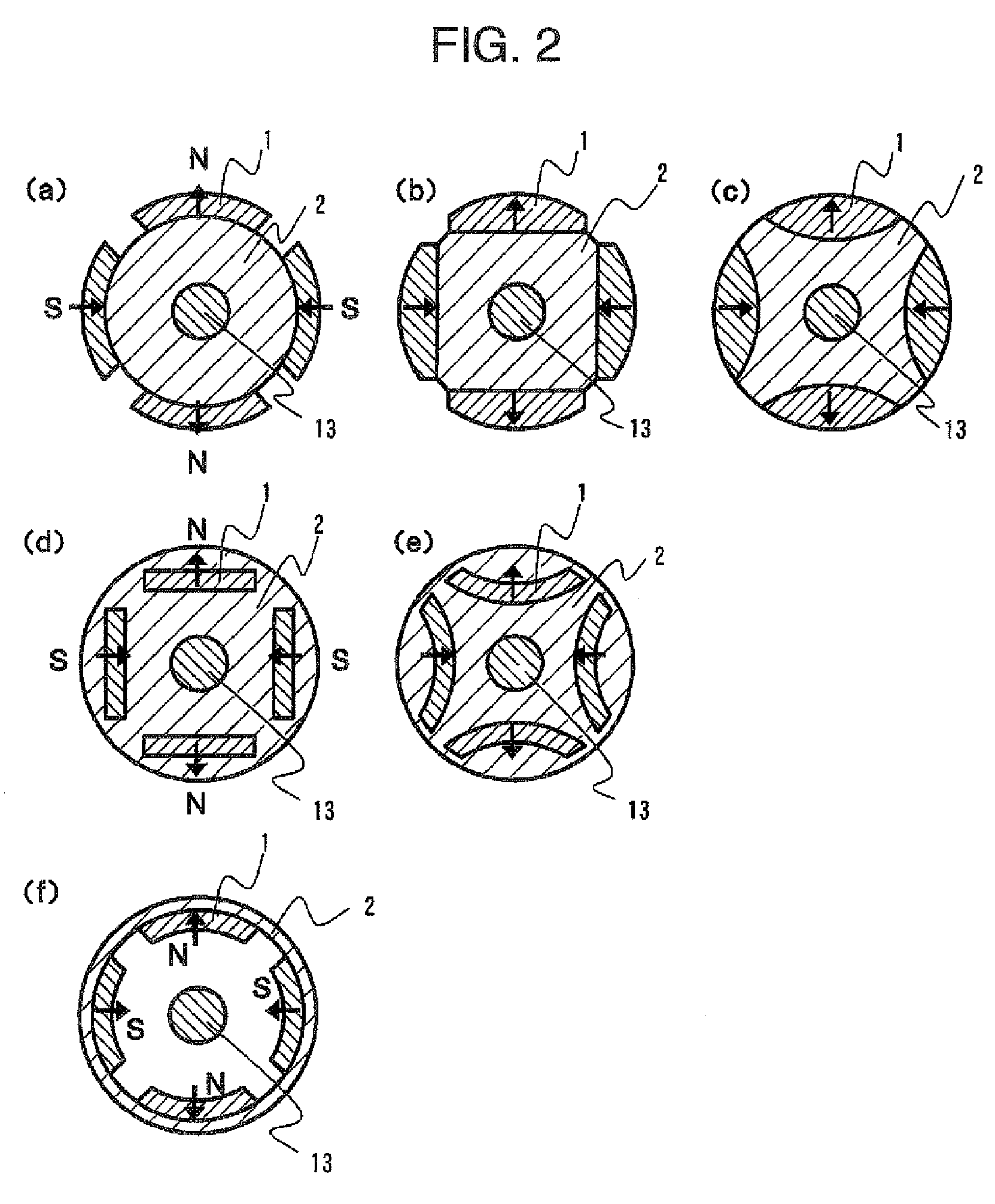Rotor for motor and method for producing the same
a technology of bonding magnet and rotor, which is applied in the direction of magnetic circuit rotating parts, magnetic circuit shape/form/construction, magnetic bodies, etc., can solve the problems of general poor thermal stability and bonding force of soft adhesive, damage to the magnet, etc., to achieve high output and efficiency, stable and small pole pitch and dispersion, and high structural reliability
- Summary
- Abstract
- Description
- Claims
- Application Information
AI Technical Summary
Benefits of technology
Problems solved by technology
Method used
Image
Examples
embodiment 1
Comparative Example 1
[0083]First, an explanation will be given to an importance in the relative, positional relationship between left and right imaging elements in a stereo camera. First, effects of making the most of that high bonding strength between a bond magnet section and a soft magnetic yoke section, which constitutes a feature of a manufacturing method of the invention, to cancel a protective ring have been examined. A protective ring as shown in FIG. 3 is essential in a conventional system (Comparative example 1), in which segment magnets are bonded. In contrast, when a rotor (FIG. 1(a)) fabricated by the manufacturing method of the invention is used, a rare-earth bond magnet section and a soft magnetic yoke section made of soft magnetic powder can be unified firmly, so that a protective ring is dispensed with and a gap between a stator and a rotor can be made small, thus enabling making further effective use of magnetic flux than in Comparative example 1. Also, a decrease ...
embodiment 2
[0089]FIG. 1 is a cross sectional view schematically showing a permanent magnet rotor according to a further embodiment of the invention. In FIG. 1, one magnetic pole is constituted by two magnets 1A, 1B, a yoke 2 made of a soft magnetic material, and a shaft 13. According to the manufacturing method of the invention, it is possible to mount a multiplicity of permanent magnets, which are complex in shape and orientation. As shown in FIG. 1, when anisotropic bond magnets 1A, 1B are oriented so that directions of magnetization of magnets indicated by arrows are made symmetrical with respect to a bonding interface 100 of the anisotropic bond magnets 1A, 1B, generated magnetic fields are efficiently concentrated in a center position of the magnetic poles shown by N(S) in the drawing, and high magnetic properties can be obtained as compared with the case where one magnetic pole is constituted by a single magnet shown in FIG. 2. An extent, to which generated magnetic fields are concentrat...
embodiment 3
[0091]FIG. 10 is a cross sectional view schematically showing a permanent magnet rotor according to a further embodiment of the invention. With a conventional ring magnet manufacturing method, although a magnet has a large thickness in a direction of magnetization as shown in FIG. 10(a), orientation and orientation of multiple poles are difficult, but stable orientation and polarization can be readily performed irrespective of the number of poles and dimensions of a magnet in the manufacturing method of the invention. Also, as shown in FIGS. 10(b) and 10(c), it is also possible to compose one pole of three magnets 1A to 1C to efficiently concentrate generated magnetic fields in a center position of magnetic poles.
PUM
| Property | Measurement | Unit |
|---|---|---|
| angle | aaaaa | aaaaa |
| shear strength | aaaaa | aaaaa |
| angle | aaaaa | aaaaa |
Abstract
Description
Claims
Application Information
 Login to View More
Login to View More - R&D
- Intellectual Property
- Life Sciences
- Materials
- Tech Scout
- Unparalleled Data Quality
- Higher Quality Content
- 60% Fewer Hallucinations
Browse by: Latest US Patents, China's latest patents, Technical Efficacy Thesaurus, Application Domain, Technology Topic, Popular Technical Reports.
© 2025 PatSnap. All rights reserved.Legal|Privacy policy|Modern Slavery Act Transparency Statement|Sitemap|About US| Contact US: help@patsnap.com



